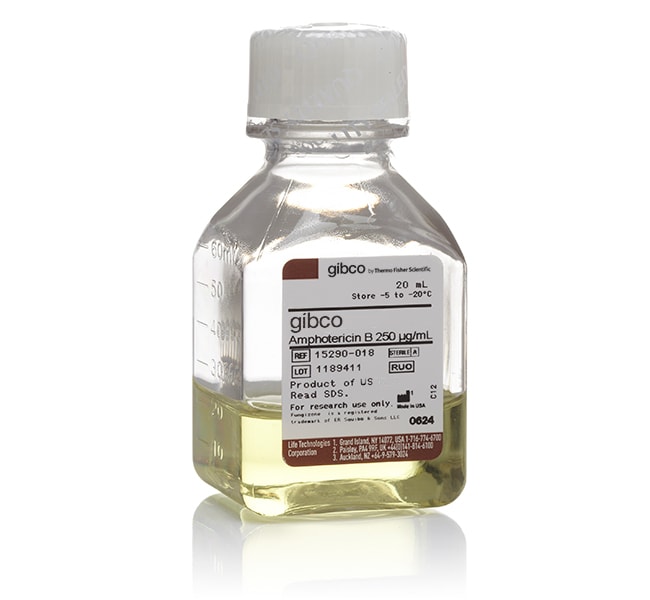Search Thermo Fisher Scientific

Amphotericin B
| Catalog Number | Quantity |
|---|---|
| 15290018 | 20 mL |
| 15290026 | 50 mL |
Dual-site cGMP manufacturing
For supply chain continuity, we manufacture Gibco Amphotericin B at two separate facilities located in Grand Island, NY and Scotland, UK. Both sites are compliant with cGMP manufacturing requirements, are certified to the ISO 13485 standard, and are registered with the FDA as medical device manufacturers.
Shipping conditions: Frozen on dry ice
Shelf life: 12 months from date of manufacture
Customers who viewed this item also viewed
Documents & Downloads
Certificates
Safety Data Sheets
Frequently asked questions (FAQs)
Amphotericin B can be freeze-thawed 2-3 times without appreciable loss of potency.
Find additional tips, troubleshooting help, and resources within our Cell Culture Support Center.
Amphotericin B in solution is stable at 2-8 degrees C for approximately 4 weeks.
Find additional tips, troubleshooting help, and resources within our Cell Culture Support Center.
Amphotericin B is the generic version of Fungizone. Fungizone is a trademark of E.R. Squibb & Sons, LLC.
Find additional tips, troubleshooting help, and resources within our Cell Culture Support Center.
When an irreplaceable culture becomes contaminated, researchers may attempt to eliminate or control the contamination.
1. Determine if the contamination is bacteria, fungus, mycoplasma, or yeast. Read more here to view characteristics of each contaminant.
2. Isolate the contaminated culture from other cell lines.
3. Clean incubators and laminar flow hoods with a laboratory disinfectant, and check HEPA filters.
4. Antibiotics and antimycotics at high concentrations can be toxic to some cell lines. Therefore, perform a dose-response test to determine the level at which an antibiotic or antimycotic becomes toxic. This is particularly important when using an antimycotic such as Gibco Fungizone reagent or an antibiotic such as tylosin.
The following is a suggested procedure for determining toxicity levels and decontaminating cultures:
1. Dissociate, count, and dilute the cells in antibiotic-free media. Dilute the cells to the concentration used for regular cell passage.
2. Dispense the cell suspension into a multiwell culture plate or several small flasks. Add the antibiotic of choice to each well in a range of concentrations. For example, we suggest the following concentrations for Gibco Fungizone reagent: 0.25, 0.50, 1.0, 2.0, 4.0, and 8.0 µg/mL.
3. Observe the cells daily for signs of toxicity such as sloughing, appearance of vacuoles, decrease in confluency, and rounding.
4. When the toxic antibiotic level has been determined, culture the cells for two to three passages using the antibiotic at a concentration one- to two-fold lower than the toxic concentration.
5. Culture the cells for one passage in antibiotic-free media.
6. Repeat step 4.
7. Culture the cells in antibiotic-free medium for four to six passages to determine if the contamination has been eliminated.
Find additional tips, troubleshooting help, and resources within our Cell Culture Support Center.
Please view the following page to browse the cell culture antibiotics we offer (https://www.thermofisher.com/us/en/home/life-science/cell-culture/mammalian-cell-culture/antibiotics.html).
Find additional tips, troubleshooting help, and resources within our Cell Culture Support Center.
